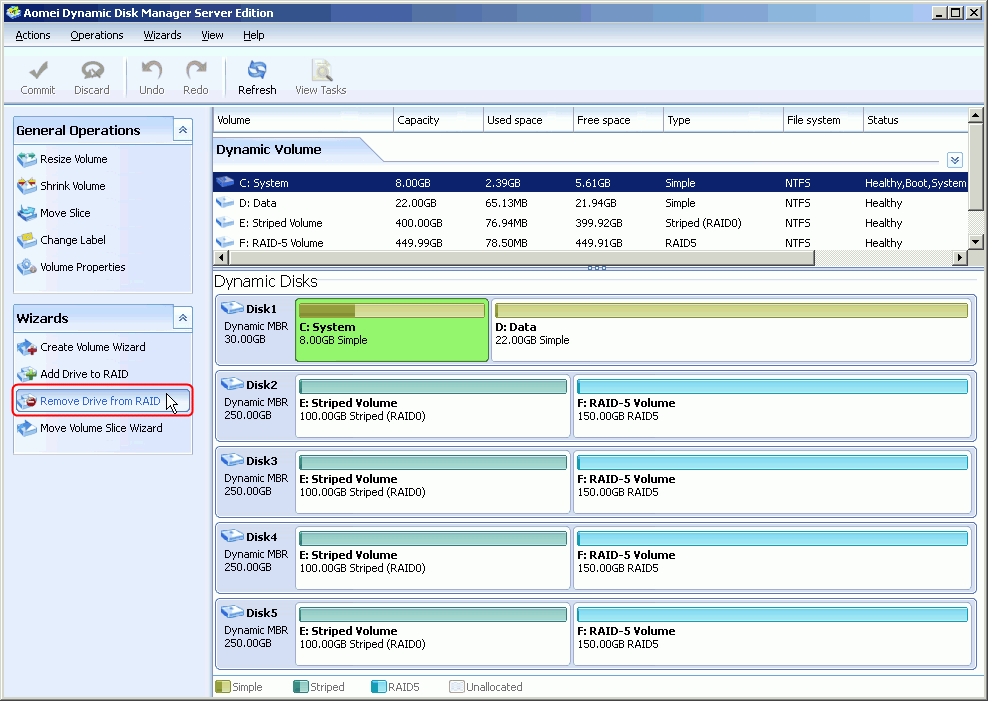

- Softraid convert disk to raid 5 mac os#
- Softraid convert disk to raid 5 full#
- Softraid convert disk to raid 5 software#
Softraid convert disk to raid 5 full#
But, hey, we do have automated regular full backups, don’t we?Īnd that’s it for the reshape. Technically, of course, it’s just as unsafe and concerning as a RAID 5 with missing parity disk. So to feel better (at least from a purely emotional standpoint, after all, a four-disk stripe is nothing that you should ever rely on), just call the above command a second time, now for the actual conversion: sudo mdadm -grow /dev/md0 -backup-file=convert5to0 -level=0 -raid-devices=4Īnd now you instantaneously have your RAID 0 stripe: md0 : active raid0 sdb1 sda1 sdc1 sdd1 😉 Because it’s still a RAID 5, and it’s still in degraded state. The underscore in the disk states is there to make you feel uncomfortable. Once the reshape completes (in my case the ~1800 minute estimation was pretty accurate), you end up with: md0 : active raid5 sdb1 sda1 sdc1 sdd1ġ1718436864 blocks super 1.2 level 5, 512k chunk, algorithm 5 That is, effectively a four-disk stripe, and a missing parity disk.
/RAIDAssistantStripeDiskSelection-58c5c12e5f9b58af5c24b8e3.jpg)
It’s converting the array to a RAID 5 five-disk array in degraded state. Monitoring the process reveals what the SW RAID implementation is really doing: md0 : active raid5 sdb1 sda1 sdc1 sdd1 The mdadm tool will back some critical data up, an then the kernel tells you: md: reshape of RAID array md0 Then all you need to do is the following call in order to reshape your array to a RAID 0 structure: sudo mdadm -grow /dev/md0 -backup-file=reshape5to0 -level=0 -raid-devices=4 So, let’s assume we have a RAID 5 array at /dev/md0, which reports the following state in /proc/mdstat: md0 : active raid5 sdc1 sdb1 sdd1 sda1Ĩ788827648 blocks super 1.2 level 5, 512k chunk, algorithm 2 Yes, OK, you really might want to grow your filesystem afterwards, but that’s really out-of-scope when talking about the RAID structure. And I was not disappointed! It’s really just a matter of a single mdadm call. And so I expected the conversion (“reshaping”) of my RAID 5 array into a RAID 0 to be simple. And with mdadm it has a really nice user interface. It always worked wonderfully for my needs. I’m talking about a home environment here, which is a Raspberry Pi CM4-PCIe-SATA-driven NAS. And I did not want to give away 3TB of capacity just for availability anymore. Because, naturally, I have nightly onsite full backups and offsite partial backups of irretrievable data. ” margin_top=”50px” margin_bottom=”” animation_type=”slide” animation_direction=”left” animation_speed=”0.Yesterday I finally converted my RAID 5 array of four WD Red 3TB disks to a simple stripe, aka RAID 0.

Softraid convert disk to raid 5 software#
[tagline_box backgroundcolor=”description=” shadow=”no” shadowopacity=”0.7″ border=”1px” bordercolor=”” highlightposition=”top” content_alignment=”left” link=”” linktarget=”_self” modal=”” button_size=”” button_shape=”” button_type=”” buttoncolor=”” button=”” title=”” description=”If you have any queries regarding software RAID 5 on Windows Server 2008, feel free to leave us a message and our representative will get back to you. This may take some time, Once the process is complete the status will change to Healthy and the RAID 5 volume is ready for use you do not have to restart the computer. On the ‘Format Volume’ screen, change the features would like you.Pick a drive letter for your new RAID5 volume, > Then click “Next”.On the ”Select Disks” screen and click,> “Add ” for the disks you wish to have added to the ‘Selected’ list.
Softraid convert disk to raid 5 mac os#


 0 kommentar(er)
0 kommentar(er)
